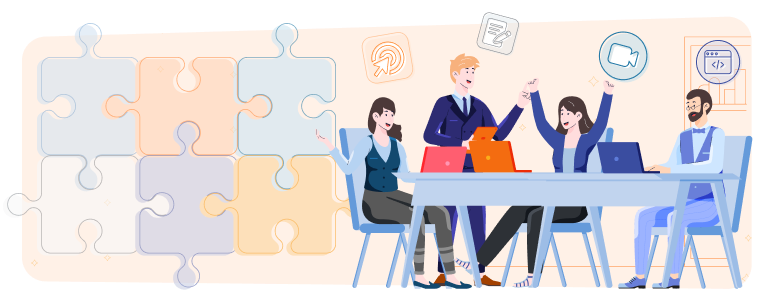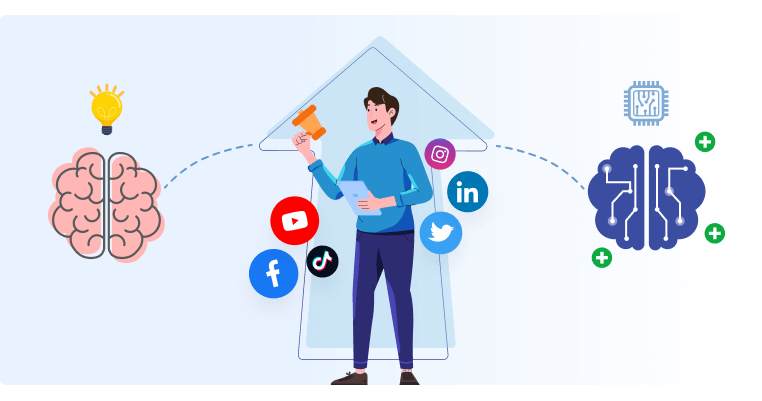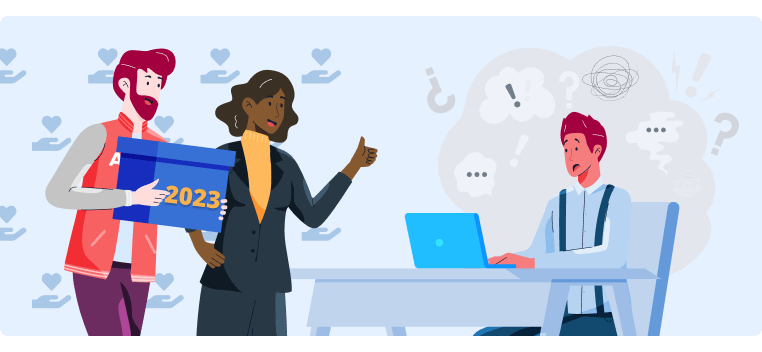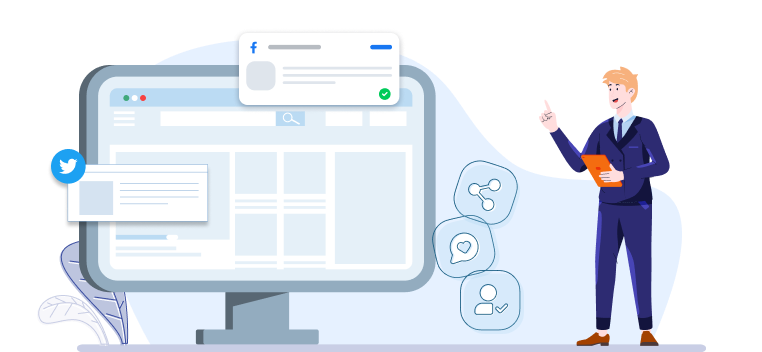The B2B Marketing Strategy Blueprint To Crush 2024
Creating a B2B marketing strategy can be overwhelming because:
-
There are hundreds of channels and tactics to choose from (and the list is constantly evolving).
-
There are dozens of potential metrics you could track.
-
There are thousands of different marketing tools available.
Every company has a slightly different B2B (business-to-business) marketing strategy, though some are certainly more effective than others.
So, how do you build the most effective marketing strategy for your business?
Instead of telling you what your B2B marketing strategy should look like, we'll walk you through a framework that will guide you through creating a custom B2B marketing strategy that's best for your business.
What Is a B2B Marketing Strategy?
A B2B marketing strategy is a plan businesses use to promote their products and services to other companies.
Within each B2B marketing strategy, there are many micro-strategies.
For example, a business's B2B marketing strategy might include SEO, influencer marketing, PPC advertising, and email marketing strategies.
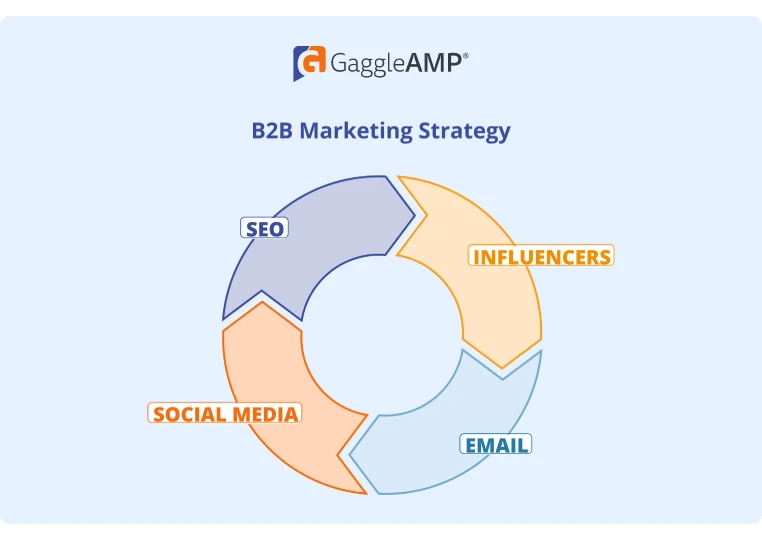
As each business has a slightly different value proposition, target audience, and budget, every B2B marketing strategy is unique.
In addition, new channels and customer expectations mean that each business's B2B marketing strategy is always evolving.
So, what's the best B2B marketing strategy for your brand?
To help you answer this question, we'll walk you through a framework your marketing team can use to create the best B2B marketing strategy for your brand.
How To Create a B2B Marketing Strategy
The simple five-step process below guides you through creating the best B2B marketing strategy for your brand. Bookmark this page and execute each step as you read.
Let's jump into it!
Step 1: Establish Your Goals
All businesses have the same end goal – growth.
However, each business has a different growth path. For example, a new startup's primary marketing goal is closing customers as quickly as possible to generate its initial revenue.
On the other hand, a more established business with more runway can invest in brand awareness and other long-term marketing strategies.
To set goals for your marketing strategy, start by looking at the company's main goals for the year. Then, build a marketing strategy to support those goals.
For example, if you're a brand new startup, the company goal might be to earn 100 customers by the end of the year. In that case, you'll probably use marketing channels that return a quick ROI, like paid ads.
On the other hand, let's say that you're an established enterprise company selling to other enterprise companies, and the goal is to increase profitability by 20%. In that case, you might invest more in account-based marketing and focus on targeting exclusively higher-budget customers and cutting lower-end customers.
We'll discuss each marketing channel in more detail, but here's a quick overview of which channels are best for different objectives:
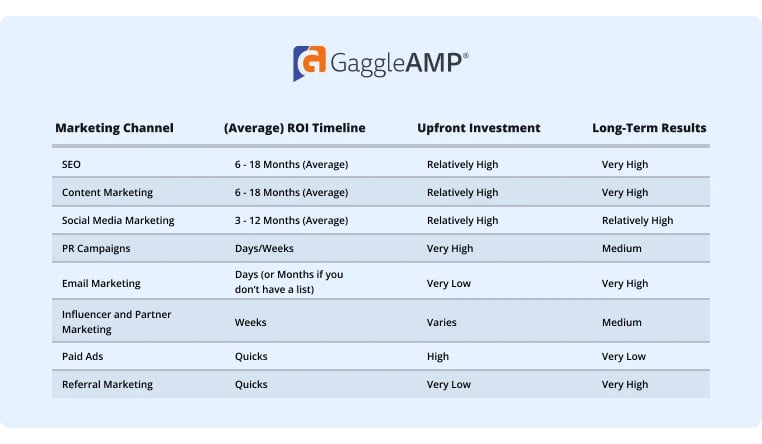
Of course, this might vary depending on the industry and even the type of end customer so treat this as a guideline. You’ll want to conduct your own analysis for your company to truly understand the results associated with each tactic.
Step 2: Conduct Customer Research
A marketing strategy is a plan to get your product or service in front of your ideal customer. So before defining a strategy, know who your customers are and where they hang out.
Most B2B companies know the general title of their target audience.
However, few companies know:
-
Who the top 20% of their customer base is.
-
Detailed information on those customers' pain points, fears, desires, and aspirations.
The former head of pricing and packaging at Vista, a $50 billion private equity firm, claimed that their main strategy to triple a portfolio company's revenue is simply identifying the top 20% of their most profitable customers and then doubling down on serving only those customers.
To do that, you need to thoroughly understand the top 20% of customers' pain points and then shift your marketing messaging accordingly.
This means you'll repel the bottom 80% of your customer base – and that's okay!
So, what does a good customer profile look like?
Here's a comparison of what a detailed customer profile looks like versus a generic customer profile:
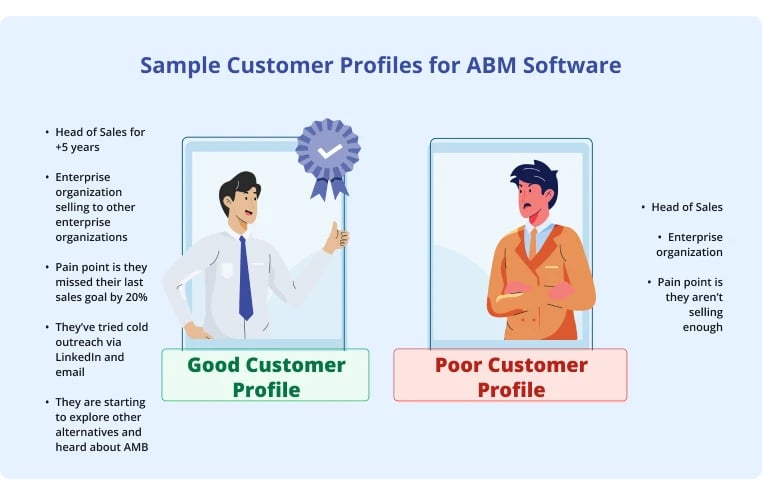
As you can see, targeting your ideal customer is much easier when you have a more detailed buyer persona, as you can craft more compelling messaging. For example, based on the customer profile above, you can switch your messaging to something like "Tried LinkedIn and cold outreach and still missed your sales goals by 20%?"
This headline will resonate with them and make your offer more compelling than a competitor's generic messaging.
In addition, this customer research can also inform your marketing campaigns. For example, if you have an SEO strategy, you might target keywords like "alternatives to cold emailing."
So, how do you create a customer research strategy?
First, create a list of your most profitable customers and then set up interviews with as many of them as possible. If you have a customer success team that frequently speaks with your customers, they can do the customer research for you.
Alternatively, you can simply send your customers a personal note and offer them an incentive, like a discount, to get on a call with you to answer some questions.
Once you're on the call, here are a few questions you can ask your customers:
-
What was the main pain point they were trying to solve before your product or service?
-
How were they solving the problem before your product or service?
-
What has been the biggest benefit of using your product or service?
-
How has the product or service impacted the company's ROI?
-
Who was involved in the purchase decision?
-
Who originally found our product or service?
-
Which channel did they find our product or service through?
You can add your own questions to this list; these are just some basic suggestions to help you get started.
Be sure to record the call and then keep track of customer responses to identify common themes.
In fact, you can use a tool like Discuss.io, which allows you to host and record the call, and then it pulls specific insights like:
-
Auto-generate clips based on keyword tags.
-
Sentiment analysis.
-
Word cloud.
This customer research data will help guide the rest of your marketing strategy, from how to position your brand, to what marketing channels you should test.
Step 3: Select the Best Marketing Channels
There isn't a single best marketing channel for all businesses, so we'll introduce you to the most common digital marketing channels below and then define:
-
How that channel works, and the best practices for success.
-
The general ROI timeline.
-
The goals it best supports (brand awareness, conversions, etc.).
This way, you'll have a framework to select the best marketing channels for your business, and you can use it to adjust your marketing strategy as your business grows and changes.
Let's jump into the most popular marketing channels.
Search Engine Optimization (SEO)
Overview: SEO helps your brand appear at the top of Google (or other search engines) when people search for a relevant keyword.
ROI Timeline: Long-term strategy – generally several months or years.
Goals It Supports: Brand awareness, potential customer relationship building, and lead generation.
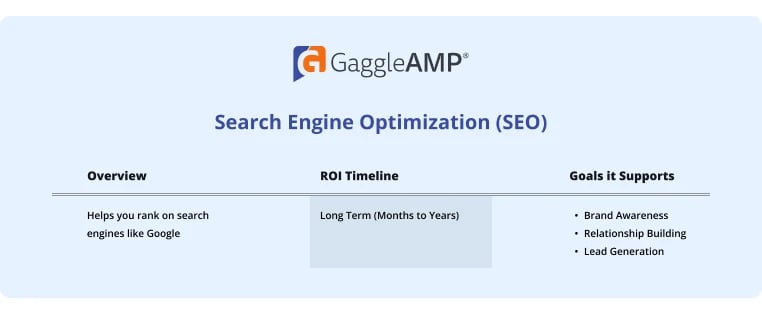
Search engine optimization is just what it sounds like – it's a strategy to help your website appear at the top of search engine results (like Google) for relevant keywords.
Most SEO strategies consist of content marketing, technical optimizations, and quality link building.

It's one of the most popular inbound marketing strategies since you don't have to pay for clicks that come to your website from the organic SERPs. Another benefit of SEO is that it requires minimal maintenance to keep a page that currently ranks in the top position.
The results also compound over time, because once search engines view your website as an industry authority, they naturally rank your new content faster.
While this is good news for established websites that have invested in high-quality SEO for a long time, it also means that newer websites with minimal authority will require more time to get rank for target keywords.
So, if your website is relatively new or has little topical authority, you probably won't see an ROI from SEO for months. Of course, this varies depending on your industry, though generally, SEO is a long-term strategy.
In addition, because SEO is designed to generate search traffic from people Googling keywords, you must also have a content marketing strategy. Without content marketing, you won't rank for many keywords simply because you won't have an answer to searcher queries.
Content Marketing
Overview: Content marketing is a strategy that allows your brand to connect with potential buyers through media like videos, blog posts, infographics, white papers, and more. The idea is that it helps you build trust with potential customers by providing valuable expertise for free.
ROI Timeline: Long-term strategy – content marketing requires consistent publishing (blogs, podcasts, videos, etc.) and may take months or years to generate an ROI. Content is also usually at the very top of the marketing funnel, meaning most people won't convert immediately.
Goals It Supports: Brand awareness, customer education, and customer retention.
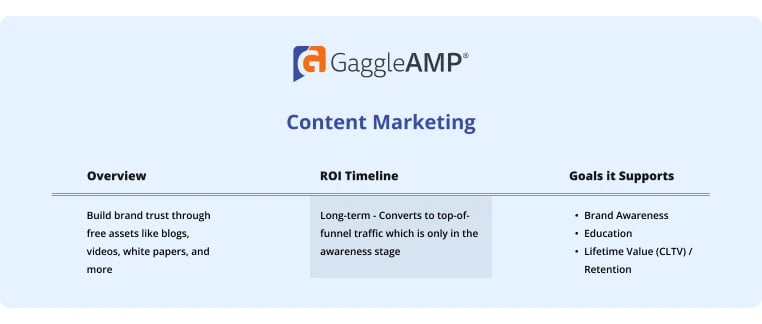
Content is often necessary for other marketing strategies, like SEO, social media, and even influencer marketing.
Measuring the ROI of B2B content marketing is notoriously difficult, though it also is one of the most effective strategies for building a reputable brand.
Instead of just tracking conversion rates from content, most brands also use metrics like brand mentions, traffic, and customer engagement to measure content success.
A handful of very successful brands have grown primarily through content marketing. Neil Patel Digital is an excellent example of a brand that has grown to over nine figures in revenue, primarily through content marketing and SEO. It was also named one of Inc 5000s fastest growing companies.
WPBeginner is another brand that grew primarily through content marketing and SEO.
While those are both examples of blog-style content marketing, a great example of a brand that uses social media and video content is Acquisition.com.
While it's technically the founder, Alex Hormozi, who built an impressive content strategy, his personal brand has fueled Acquisition.com's explosive growth from zero to $150 million in just a couple of years.
Social Media Marketing
Overview: A social media marketing strategy uses one or multiple social media channels to connect your brand with potential customers. The most popular B2B social media channels include LinkedIn and Twitter, though many brands also use TikTok, YouTube, Instagram, and Facebook.
ROI Timeline: Long-term strategy – most social media strategies are designed to increase brand awareness and early touchpoints with the customer rather than drive immediate conversions.
Goals It Supports: Brand awareness, customer education, and customer retention.
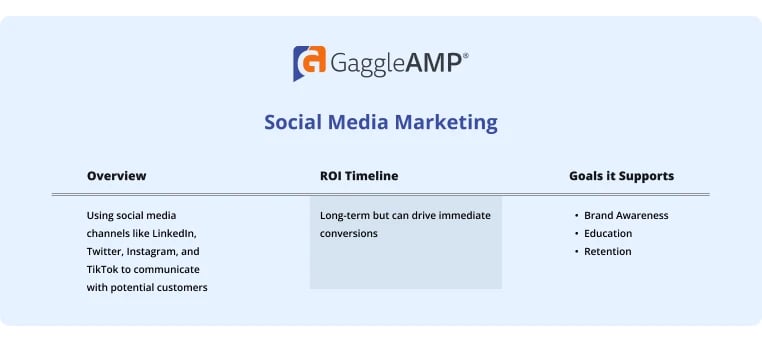
Social media marketing is a great strategy for more established brands that want to generate more brand awareness.
If you already have a content strategy, social media is a great promotion tool; you can repurpose your existing content on different social media platforms with minimal additional effort.
Here’s a great example of social media promotion in action:
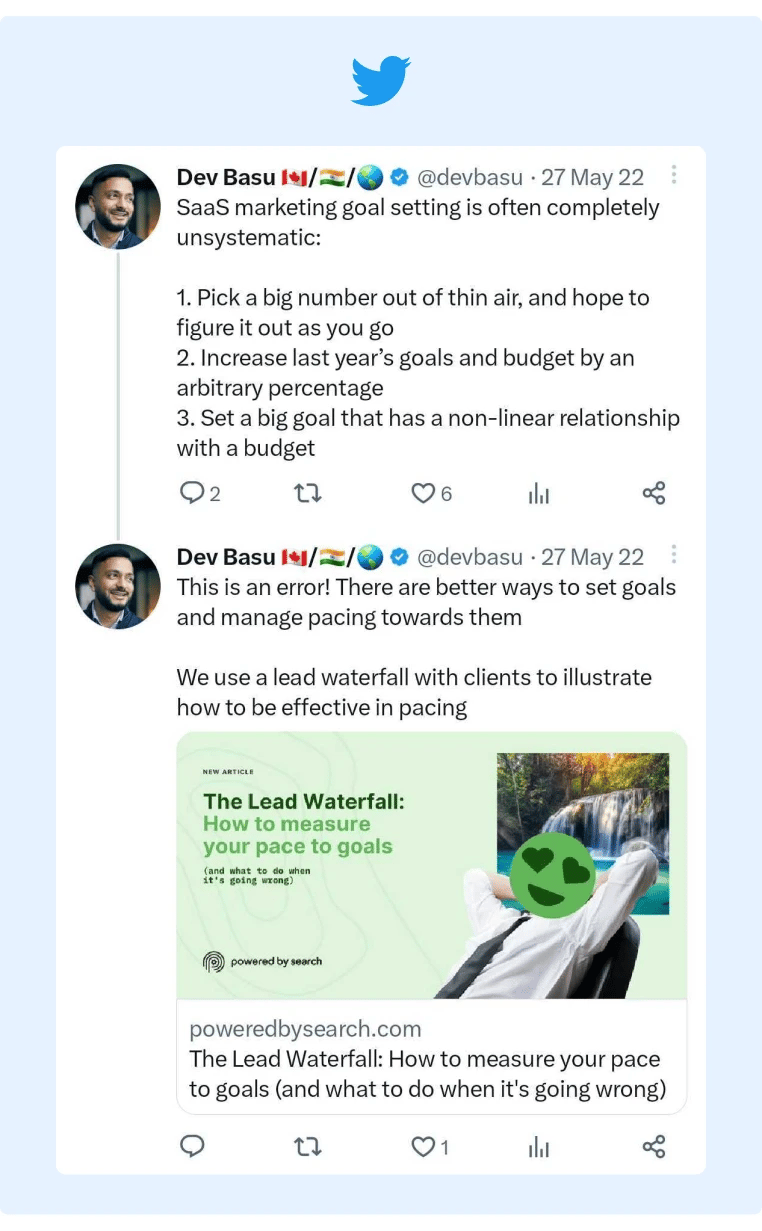
In addition, if you plan to run paid ads on a social media platform, or even influencer marketing campaigns, it's worthwhile to invest in an organic social media strategy so that interested people can learn more about your brand.
Another benefit of social media marketing is that it allows B2B brands to talk directly with their audience. This is unique from most other marketing channels that don't allow you to converse one-on-one with your customers.
A downside of social media is that social platforms can ban you or change the algorithm at any time. To prevent losing your audience overnight, drive your social media followers to your website and capture their email (or some other contact info) so that you can communicate with them even if you no longer have access to that social media platform.
Email Marketing
Overview: Email marketing allows your brand to communicate with customers and potential customers at scale. It's great for sending educational content, promoting new launches, moving new audiences through the buyer's journey, and keeping your brand top of mind.
ROI Timeline: Building a list can take time, though you can see a fairly fast ROI once you've built a high-quality list. It also requires very little capital to launch an email list or to build a campaign when you're using an email template builder.
Goals It Supports: Lead generation, immediate conversions, content promotion, and building customer relationships.
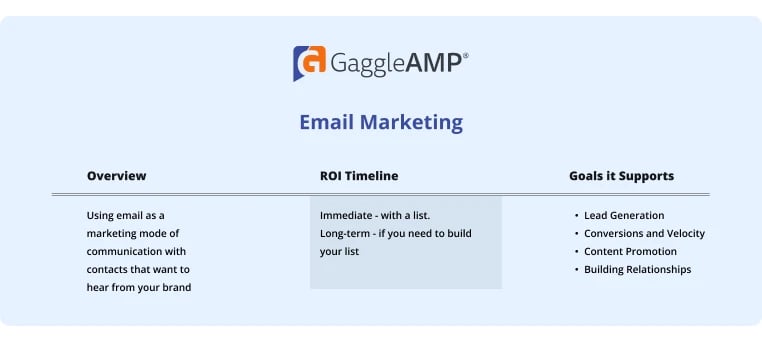
Email may seem like an older marketing strategy, but it's still a highly effective method to build a relationship with B2B customers and drive sales.
In fact, marketing expert Brian Dean shared that email marketing has been a primary growth lever for his company, Exploding Topics.
A key consideration when building an email list is the quality of the subscribers. For example, copywriter Justin Goff has an email list of just 9,200 people, yet he makes about $1.6 million per year from it.

So, you don't necessarily need hundreds of thousands of people on your list to make a lot of money from it.
In fact, regularly cleaning your email list is a good best practice since it will help you improve email delivery rates.
Even if you don't intend to start an email marketing strategy immediately, building an email list is a good idea. You'll at least have the option to communicate with those potential customers in the future.
In addition, it requires minimal capital to start an email list (typically less than $100 if you only have a few hundred subscribers).
Influencer and Affiliate Marketing
Overview: This strategy lets you partner with other brands (either individual people or media companies) that own your ideal audience. These brands then promote your products and services to their audience.
ROI Timeline: A well-executed influencer or affiliate marketing program can generate a fairly immediate ROI. Affiliate marketing tends to produce a long-term ROI as they can promote your products or services as often as they wish, though most influencer marketing campaigns have a set end date.
Goals it supports: Brand awareness, lead generation, and immediate conversions.
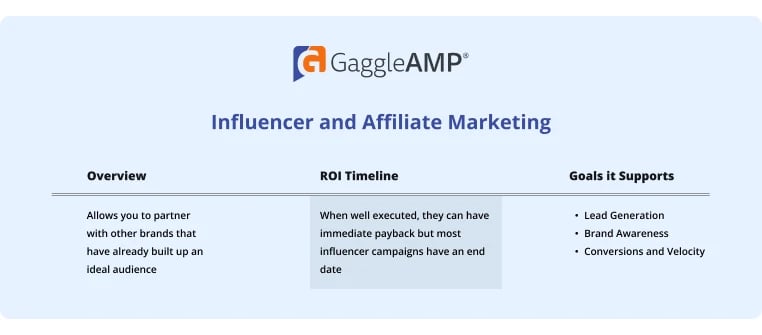
Building a high-quality audience takes a long time and a lot of resources. While we recommend implementing an SEO, social media, and content marketing strategy to build that audience, the best way to "borrow" access to your ideal audience is through influencer and affiliate marketing.
So, while you're waiting for your organic marketing strategies to kick in, you can generate more brand awareness and leads through affiliate and influencer marketing.
There are slight differences in how affiliate marketing and influencer marketing partnerships are typically structured.
With influencer marketing, you typically pay the influencer up front to promote your products and services. On the other hand, most affiliate programs are structured based on commission – so you only pay affiliates a percentage of the sales they generate (similar to referral marketing).
While influencer marketing is more common in B2C marketing strategies, you can reach out to parallel brands and ask to partner with them. For example, you could offer to do a joint webinar or podcast with one of their key executives.
Influencer Marketing Hub is an excellent example of a B2B affiliate marketing website that partners with brands to send relevant traffic to their websites.
For example, this page promotes a handful of agencies. Then, when someone visits the agency website from that page and purchases the services, Influencer Marketing Hub receives a commission.
Paid Ads
Overview: Paid ads allow you to pay a platform to get your marketing messaging in front of your ideal audience. You can run paid ads on social media platforms, search engines (like Google), and even industry publications.
ROI Timeline: You can see an ROI within days of turning on ads, though they also quit producing an ROI the instant you turn them off.
Goals it supports: Lead generation, immediate conversions, and content promotion.

The main benefit of paid ads is that they return fast results, and it's relatively easy to calculate the ROI of your ad spend (at least, in comparison to other marketing tactics).
The biggest downsides of ads are:
-
They typically don't produce a long-term ROI. (You stop seeing results as soon as you turn them off.)
-
Ad costs continue to rise across all marketing channels.
Instead of using paid ads as your primary marketing channel, use them as fuel to power the rest of your brand strategy.
To get started with paid ads, you can do some competitive research to analyze how your competitors tackle advertising.
To see your competitors' Google ads, you can use a tool like Semrush, which will show you paid keywords they're targeting, the landing pages they're running ads to, and more.
If you're running Facebook ads, the Facebook Ad Library allows you to see your competitors' exact ads, different variations, and even how long they've been running each ad.
If you want to check out your competitors' LinkedIn ads, you can simply visit their branded page, click on "Posts," and then sort by "Ads."
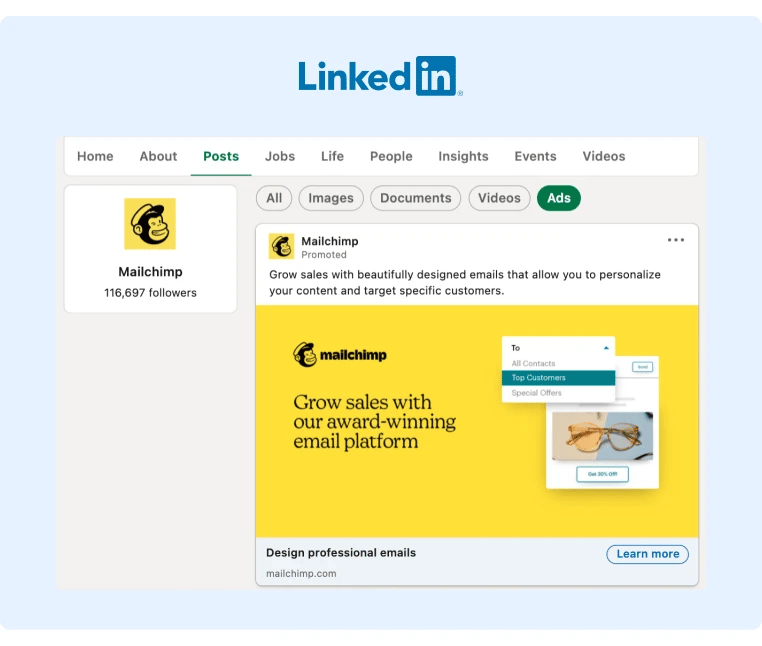
As you're auditing your competitors' ads, be sure to look at the type of ads they're using and how they fit into the broader marketing funnel.
For example, they may be running retargeting ads to a landing page to book a sales call. In that case, the goal is clearly to drive conversions.
However, they may also be running ads to relevant content like a blog post. In that case, the goal is probably to drive more brand awareness and educate potential customers.
So, instead of reinventing the wheel, use your competitor's strategy as a template to help you get started. Then you can create your own strategy after gathering some data.
Referral Marketing
Overview: Referral marketing strategically encourages your existing customers to bring you more qualified leads by telling their friends and connections about your services.
ROI Timeline: You can see an immediate ROI when you implement your referral marketing strategy, though the average ROI depends largely on customer satisfaction.
Goals it supports: Lead generation, immediate conversions, and improving customer loyalty.
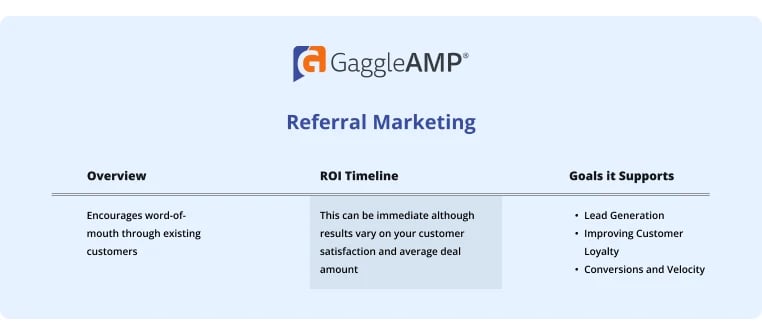
Referral marketing is usually the fastest way for startups to win their initial customers, and more established businesses can also use it to scale their customer base.
It's a particularly effective marketing channel for service-based businesses, like agencies and coaches, as clients tend to choose their service providers based on relationships.
There are a few unique benefits of referral marketing.
First, referral marketing helps you drive more high-quality customers.
Why?
Your customers tend to have very similar friends. If you identify your top 20% of customers and ask them for referrals, you'll be able to acquire more of your top 20% of customers.
Another benefit of referral marketing is that it costs virtually nothing to start a referral program. You can always offer rewards to customers for sending new customers, though the benefit is that you only pay when other customers bring you new customers.
So, it's one of the few marketing channels that is almost impossible to lose money on.
Even if you have zero customers right now, you can offer to provide free products or services in exchange for referrals and a testimonial.
Step 4: Execute Your Strategy With Consistency
Most companies are good at designing a digital marketing strategy. Fewer companies execute that strategy with consistency.
To improve your execution, here are three things to ask:
-
Who: Who has already executed a similar strategy for a similar brand, and can we either hire that person or swipe their blueprint?
-
How: If execution isn't consistent, it's probably because there aren't systems and processes in place. To solve this, you can use a project management tool like Monday.com or Asana to map out how the project will get done.
-
When: Create a deadline for the project so that you can measure results and identify what worked and what didn't work.
Successful companies typically aren't doing a lot of new things – they're usually just consistently doing the same boring things that work.
Most marketing strategies require time to produce a significant ROI, so if you never give them time to compound, you'll probably find that nothing works.
Once you've designed a B2B marketing strategy, don't get distracted by shiny new marketing tactics. Just focus on flawless execution.
Step 5: Test and Reiterate
Every quarter, look at key metrics to identify what marketing strategies brought you closest to the goals established in step one.
In addition to analyzing the effectiveness of all of your marketing channels as a whole, look at which campaigns within each marketing strategy drove the best results.
For example, if you're investing in content marketing and created 10 blog posts over the quarter, which one drove the most traffic? The most backlinks? The most conversions?
You can then use that data to choose which keywords and topics to target.
Once you've thoroughly analyzed what works, cut channels and campaigns that didn't work and double down on the ones that worked best.
As you improve your B2B marketing strategy, you should be doing less rather than more.
The only caveat is that it's important to remember that some channels (like SEO and content marketing) take longer to generate an ROI. However, you can still measure your general strategy's success by looking at early metrics like traffic, brand mentions, and other engagement metrics.
Start Your B2B Marketing Strategy Today
If you followed the steps in this post, you now have a marketing plan optimized to attract your ideal B2B buyer!
Many marketers overanalyze the planning process and spend too much time studying existing marketing examples. Instead, just take action and follow the steps one at a time.
If you don't have the bandwidth to take action on each step, you can always automate tasks with marketing tools to buy back your time.
The key is to get started now and adjust your strategy as you grow.






